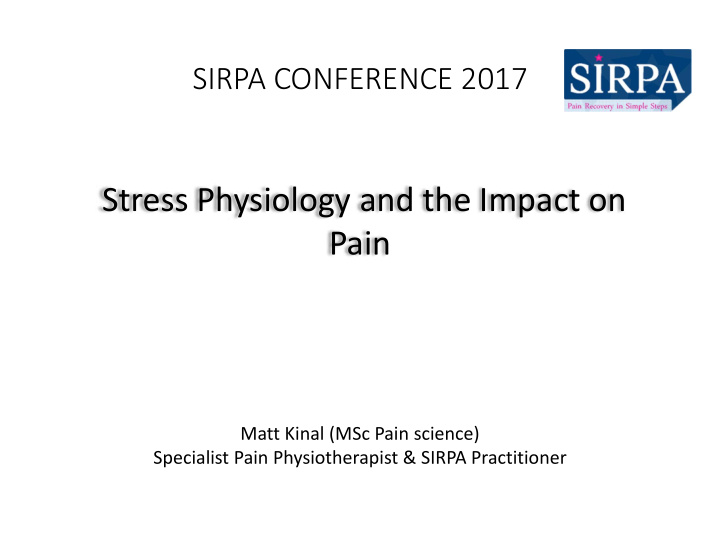



SIRPA CONFERENCE 2017 Stress Physiology and the Impact on Pain Matt Kinal (MSc Pain science) Specialist Pain Physiotherapist & SIRPA Practitioner
The evidence for stress causing pain?
The stress response Acute Stress
The stress response Chronic Stress
Cortisol Fluctuations
Dysfunctions of the HPA axis ‘ Adult cortisol levels can be affected by early adverse life events’ Nicolson (2004) Childhood parental loss and cortisol levels in adult men. Psychoneuroendocrinology 29: 1012-1018 ‘And can predict the failure of back surgery’ Geiss et al (2005) Predicting the failure of disc surgery by a hypofunctional HPA axis: evidence from a prospective study on patients undergoing disc surgery. Pain, 114: 104-117
Dysfunctions of the HPA axis
Animal studies – Effects of stress • Acute restraint stress (90mins) caused an analgesic response compared to chronic restraint stress (7days), which cause a hyperalgesic response. Costa et al (2005) Effects of acute and chronic restraint stress on nitroglycerin-induced hyperalgesia in rats. Neuroscience letters. 383: 7-11 • Chronic social defeat can cause spinal neuroinflammation, enhancing pain and cause anxiety-like behaviour. Rivat et al (2010) Chronic stress induces transient spinal neuroinflammation, triggering sensory hypersensitivity and long-lasting anxiety-induced hyperalgesia. Pain, 150: 358-368
Fear and anxiety Different physiological effects • RHUDY, J.L. & MEAGHER, M.W., (2000) Fear and anxiety: divergent effects on human pain thresholds. Pain, 84 (1): 65-75
Reorganisation of the brain and nervous system in response to stress
fMRI Studies
The Central Nervous System
Central sensitisation Central sensitisation is linked with a variety of different conditions including: • Chronic lower back and neck pain • Fibromyalgia • IBS • Temporomandibular joint disorder • Interstitial cystitis Kindler et al (2011) Central Sensitivity Syndromes: Mounting Pathophysiologic Evidence to Link Fibromyalgia with other Common Chronic Pain Disorders. Pain Management Nursing 12(1): 15-24
A vicious cycle BRAIN BODY
Stress and Pain • Workplace stress: ‘Work place bullying was found to increase the incidence of newly diagnosed fibromyalgia’ (Kivimaki et al., 2004) • Other than a history of lower back pain, psychological distress was the only other factor found to have an influence on new episodes of LBP ( Feyer et al., 2000) • Lack of sleep: Insomnia appears to be a risk factor for LBP (Agmon & Armon, 2014)
Stress and pain Previous trauma: • Up to 80% of people with severe PTSD suffer from ‘unexplained chronic pain’ (Egloff et al., 2013) Early life events: • There were strong correlations between traumatic events in childhood such as institutionalisation, death of a parent or separation from a parent and chronic pain in later life (Jones et al., 2009)
Anna Karenina
How often do we talk about Stress? • Despite one study reporting that 60-80% of primary care visits may have a stress related component (Avey et al., 2003) • Of 34,065 visits to 1,263 Physicians in the United States, only 3% included advice on stress management ( Nerurkar et al., 2013)
In summary • Stress can trigger neuroendocrine, neuroplastic and neurophysiological response that can influence pain • Whether you agree that stress can trigger pain or not there is certainly evidence to suggest that it needs to be recognised and managed in the acute and chronic phase of pain • There probably isn’t one mechanism by which stress causes or influences pain, instead there are a multitude of mechanisms. • This reflects the complexities of an individual and highlights why we need to treat people as individuals.
References • Kivimaki et al (2004) Work Stress and incidence of newly diagnosed fibromyalgia – Prospective cohort study. Journal of Psychosomatic Research. 57: 417-422 • Feyer et al (2000) The role of physical and Psychological factors in occupational low back pain: a prospective cohort study. Occupational Environmental Medicine. 57: 116-120 • Agmon & Armon (2014) Increased Insomnia Symptoms Predict the Onset of Back Pain among Employed Adults. Plos One. Vol 9 (8): e103591 • Bair et al (2003) Depression and Pain Comorbidity. Archives of Internal Medicine. Vol 163 (10): 2433- 2445 • Egloff et al (2013) Traumatization and chronic pain: a further model of interaction. Journal of Pain research. 13 (6): 765-770 • Jones et al (2009) Adverse events in childhood and chronic widespread pain in adult life: Results from the 1958 British Birth Cohort Study. Pain 143: 92-96 • Avey et al (2003) Healthcare Providers Training, Perceptions and Practices Regarding Stress and Health Outcomes. Journal of the National Medical Association 95 (9): 836-845 • Nerukar et al (2013) When Physicians Council About Stress: Results of a National Study. JAMA Internal Medicine 14; 173 (1): 76-77
References • Martenson et al (2009) A Possible neural basis for stress-induced hyperalgesia. Pain 142: 236-244 • Lorenz et al (2003) Keeping pain out of the mind: the role of the dorsolateral prefrontal cortex. Brain 126: 1079-1091 • Berna et al (2010) Induction of Depressed Mood disrupts Emotion Regulation Neurocircuitry and Enhances Pain unpleasantness. Biological Psychiatry 67: 1083-1090 • Apkarian et al (2004) Chronic Back Pin is Associated with Decreased Prefrontal and Thalmic Gray Matter Density. The Journal of Neuroscience 24(46): 10410-10415 • Kong et al (2010) Intrinsic functional connectivity of the periaqueductal gray, a resting fMRI study. Behavioural Brain Research, 25; 21(2): 215-219 • Eisenberger & Lieberman (2004) Why rejection hurts: a common neural alarm system for physical and social pain. Trends in Cognitive Sciences. 8 (7): 294-300 • Brown et al ( 2013) When the brain expects pain: common neural responses to pain anticipation are related to clinical pain and distress in fibromyalgia and osteoarthritis. European journal of neuroscience 39: 663-672 • Kucyi et al ( 2014) Enhanced Medial Prefrontal-Default Mode Network Functional Connectivity in Chronic Pain and It’s Association with Pain Rumination. The Journal of Neuroscience 34 (11): 3975 -3969
Recommend
More recommend